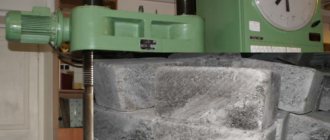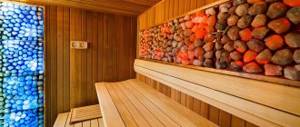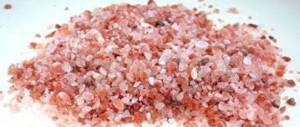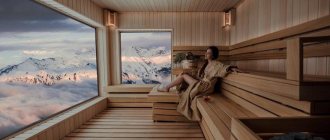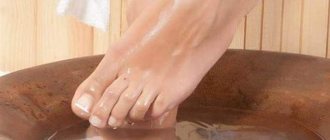In ancient times, salt was worth its weight in gold. The reason for this was the complex technology for evaporating the brine, which required a lot of firewood and a lot of time. A little later, as the Wild Field was being developed, the Chumaks brought the precious mineral from the Sivash estuaries. The Milky Way in the south is called the Chumatsky Way, and indeed, it’s like salt is scattered across the blue-black night sky.
But everything flows, times change. Nowadays there is plenty of salt, in a wide variety, and the price is such that it is possible to use the once precious product for purposes other than its intended purpose. For example, how do you like bath salt? A very fashionable topic these days. Our story today is about her.
Where fish splashed yesterday, dynamite explodes blocks
Lines from a famous poem from the era of widespread industrialization, in principle, correctly reflect the main milestones in the process of the birth of a salt deposit and its development. Only the fish splashed, for a minute, not yesterday, but a million years ago. And practically no one opens a salt massif with dynamite. There are other methods and other tools for this, more elegant.
Main salt extraction methods:
- Evaporation - evaporation of salt from a brine solution. This method is quite expensive in terms of energy consumption, but it allows one to obtain secondary salt with a low content of accompanying impurities. In the Russian North, the Pomors somewhat improved this method and divided it into stages. First, the brine was frozen, increasing its concentration due to the freezing of fresh water, and only then evaporated;
- Self-settling is a method of forming salt deposits as a result of the natural evaporation of sea water in a hot climate;
- Sadochny - extraction of salt sediment from the bottom of natural reservoirs - salt lakes or caves;
- A dry method for developing dewatered rock salt layers using a quarry or mine method. Salt extracted in this way is subsequently subjected exclusively to mechanical processing, grinding, sifting, fractionation, but not thermal or water treatment.
Watch the video for more details:
Man and salt
Rock salt, for the most part, consists of chlorine and sodium ions. Chlorine - participates in the formation of hydrochloric acid, which is the determining component of the secretion of gastric juice, sodium is responsible for the transmission of nerve impulses in the muscles, determining the degree of performance and endurance and their general functionality. Extremely important, isn't it?
It seems that no doping is needed, I ate a kilo and a half of salt at breakfast and at lunchtime I went to set another world record. However, it is not. Everything is good in moderation and salt is no exception. In modern medicine, there has been a serious discussion about what should be considered white poison: salt or sugar? It turns out that an excess of salt is a very harmful phenomenon for the human body, in all its manifestations.
For clarity, let's look at the table. It shows the chemical composition of the salt, depending on the method of its extraction, in % by weight:
| Active substance | Self-planting | Evaporation | Stone |
| Moisture | 0,2-3,3 | 2,2-2,6 | 0,2-0,9 |
| Sodium chloride | 98-99,3 | 94,8-96,0 | 98.5-98.7 |
| Calcium salts | 0,02-0,40 | 0.3-0.4 | 0.3-0.5 |
| Magnesium salts | 0,02-0,40 | 0.1-0.2 | 0.1-0.3 |
| Sulfates | 0,02-0,50 | 1,3-1,8 | 0.01-0.70 |
| Insoluble impurities | 0.1-0,4 | 0.1-0.2 | 0.1-0.2 |
Watch the video for more details:
What is Himalayan salt
Himalayan salt is also suitable for cooking dishes, making them more piquant and delicious.
This is rock salt that is mined in Pakistan from the Khewra salt mine. It is located just 300 km from the Himalayan mountain range, which is why the mineral bears this name. According to the latest research, this salt was formed during the Jurassic period during volcanic processes between India and Eurasia. It appeared simultaneously with the Himalayas, after which it began to slowly settle down and accumulate - this is how the deposits that are now developed by people were formed.
Features of Himalayan salt are as follows:
- salty-sweet taste, unlike ordinary table salt;
- soft pleasant aroma;
- pink-orange color due to impurities of iron and other minerals;
- about 90 different microelements in the composition;
- 100% digestibility by the body;
- the lowest content of sodium chloride among all types of salt (for example, table salt consists of 98% of it, which is why it is harmful in large quantities);
- manual mining without the use of machines or explosives;
- no refining;
There are other deposits in different countries, but all of them are one way or another close to the Himalayas
Most often, the mineral has a pink or reddish color, but a black tint is also observed. This unusual color scheme makes the Khewra mine a popular tourist attraction. Among all the salt mines, including the extraction of ordinary table salt, Khewra ranks second in terms of production volumes, and third in terms of mineral reserves.
Black Himalayan salt is very similar to pink salt in structure and nature. It is distinguished by a pungent odor of hydrogen sulfide, but when heated it completely disappears. Black salt is also suitable for consumption. Hindus add it to traditional spices and to the national dish raita.
Salt, fire and water
We will not take bread from medical academics and determine the importance or harm of salt entering the body with food. Let's turn to such an issue as salt in the bath. Indeed, it is not easy to overdo it with introducing salt into the body in this way, but the positive effect is obvious.
Positive effects of bath procedures with salt
There are many positives, for example:
- Salt for saunas and baths creates a wonderful atmosphere when taking procedures. There is a feeling, and not a false one, that you have been to the seaside, oh well, why be modest, to the ocean coast;
- For problems of the upper respiratory tract, aeration with salt minerals gives a guaranteed and long-term effect. It is worth remembering salt rooms for asthmatics in the system of physiotherapeutic procedures in healthcare dating back to Soviet times. Some went further, for example, on the basis of the exhausted horizons of the salt mines of the Artemsol Production Association in the city of Bakhmut, salt sanatoriums were organized with a massive intake of patients in a year-round format. It is unnecessary to say that in conditions of high temperatures and humidity the effect of salt procedures increases by an order of magnitude;
- Salt is an excellent agent that suppresses pathogenic microflora. Infectious and skin diseases have direct indications for the use of salt therapy, in which rock bath salt is an inexpensive and at the same time extremely effective tool;
- Sauna salt perfectly normalizes skin and muscle tone. Moreover, the effects of elevated air temperature and salt minerals create a complex effect, complementing each other in a balanced manner;
- Even such scourges of modern man as excess weight and hypertension are corrected with the help of salt therapy. They are being corrected. There is no need to be overly optimistic in this matter. Only the comprehensive use of systemic treatment can provide a real effect. In which various activities complement and balance each other.
How to use mineral in construction
To glue salt bricks, a special composition is used - caustic magnesite and magnesium chloride in a ratio of 3:5. First, part of the salt is dissolved in water, and then magnesite is added. The mixture dries quickly, so the blocks are glued together in no more than 4 hours. You can also use liquid glass, but it is less durable than the mixture. If you need to choose different shades for beautiful masonry, you can use tile adhesive.
Advice from the master!
To make the wall in the bathhouse look more captivating, LED strips are used for lighting. The brightness of the backlight depends on the power of the tapes. If desired, you can install a light intensity regulator. The diffused glow of the salt crystals creates a warm, romantic aura that allows vacationers to completely relax.
Himalayan salt is heat resistant. It can withstand up to 500 °C. Salt bricks or slabs can even be used to build fireplaces. The higher the temperature of the mineral, the more intense the evaporation of useful ions occurs. This means that a small distance in the sauna from the salt bricks to the heat source provides a greater healing effect. Return to content
Himalayan salt interior finishing options
When building baths and saunas, materials made from Himalayan salt are used to create an original design and enhance the beneficial effects of visiting these establishments. These include:
- brick cut from large crystal;
- tiles are an economical alternative to brick, made by pressing;
- blocks for building walls;
- cubes as a fragment of a wall.
Products made from Himalayan pink salt are used to decorate ceilings, walls, floors, and stoves. The popularity of these types of building materials is due to their healing properties and unusual color - from pale pink to orange and red.
High strength, heat resistance, and original texture make it possible to use salt products to create original decor for steam rooms and relaxation rooms.
Each type of material has its own purpose.
Application of bricks and blocks
Brick or block floors are good for foot health. Thanks to their antiseptic properties, people can walk on them without shoes. Relaxation occurs, the skin of the feet becomes soft and elastic.
Bricks and blocks are distinguished by the natural roughness of the front edge. Color, pattern, structure, and most importantly, naturalness and benefits for the body distinguish products from artificial building materials.
Bricks made from Himalayan salt are used for the construction of partitions, wall decoration, and ceilings. Another use case is to create a small niche where lighting is placed, and the entrance is blocked with bricks.
INTERESTING: How to make natural lipstick at home
Using Tiles
Since significant funds are spent on purchasing bricks, smooth tiles made from Himalayan salt are often used for cladding.
Often, to make the heater a stand-out decorative element, it is covered with tiles. This should not be done, since water falling on the building material gradually destroys it.
The optimal method of using slabs is to lay out a wall or floor panel made of pink salt , which will please the eye with diffused light and create glare when mounted on the back side of LED elements.
Note that the thickness of the product affects light transmission. Since the tile is half as thick as a brick - 2.5 cm, the backlight will be brighter.
The panel can be of any size, smooth or rough. The most budget-friendly option is to stick a scattering of Himalayan salt crystals on a section of the wall or lay out a longitudinal or transverse strip of slabs along the wall with LED elements.
Tiles are used to decorate the ceiling, walls of the steam room, as well as any structure of the rest room.
Cubes are used to create compositions and geometric shapes, embedding them into any base.
Lampshade with salt
A lampshade is a good decorative element, but in a bathhouse it also serves a practical function. After all, the lighting device hidden behind the lampshade is used in conditions of high temperatures. So it should be:
- reliable in design;
- made from durable materials;
- moisture resistant;
- fireproof.
A lampshade made of wood with Himalayan salt will fit perfectly into the interior of the bathhouse.
Most often, lampshades are placed in the corners of the bathhouse directly under the ceiling or even close to it. There is a lighting fixture in the very corner, and between it and the wall of the lampshade, as can be seen in the photograph, there are Himalayan salt stones.
Materials from which you can make a lampshade for a bath:
- Tree. This option is good because the walls of the room are most often decorated with wood, and therefore the lampshade fits well into the interior. Also in favor of wood are its naturalness and environmental friendliness.
- Heat-resistant plastic, aluminum or stainless steel. These materials can be put on the same level, because they are slightly inferior to wood due to their chemical composition.
- Durable frosted glass. Used for decorative purposes, it provides endless design possibilities.
- Himalayan salt. Sometimes the lampshade is made from salt slabs. It's not cheap, but it's very effective.
Himalayan salt with illumination - original and useful
How to use material containing Himalayan salt? How to use the substance for a bath? If salt is used as decoration, you can turn on the backlight. After all, it creates a unique play of light and a calming, relaxing environment. For illumination, LED strips are used, which are placed behind the salt wall. The power of the LED strip is selected according to the thickness of the masonry. The use of power supplies with adjustable glow intensity allows you to create a soft, uniform glow in the sauna, which is beyond the power of artificial lamps.
Bowl of salt
The bowl is perhaps the most budget option. To bring it to life, you just need to buy a decorative bowl that would fit the interior of the bathhouse, place Himalayan salt inside in any form (pebbles are most often used) and hang it from the ceiling or wall mount. The materials are absolutely unlimited; the choice of appearance and shape of the bowl depends on the taste of the owner.
It is recommended to place the bowl close to the heat source so that the evaporation of the Himalayan salt is as intense as possible.
Adviсe
When building salt baths and saunas, follow the recommendations:
- Use only natural materials.
- Finishing tiles will cost less than brick.
- To illuminate the salt walls and ceiling, install LED strips with a brightness control.
- Consider a ventilation system that will extend the life of products made from Himalayan salt.
- Cold and high humidity outside are not suitable for construction, since the optimal conditions are dry, warm weather.
- Use a composition of three parts magnesite, five parts magnesium chloride as glue; masonry using liquid glass is less durable.
- Use special glue for Himalayan salt - the simplest option for gluing salt to wood, plaster, and brick.
- Make sure that both surfaces to be joined are dry and free of condensation.
- Avoid drafts until fully bonded.
- Do not allow water to get on the wall, as over time, gullies will form.
- Maintain optimal humidity in the room - up to 50%.
Himalayan salt tiles are cheaper, but the bricks and blocks are stronger. Only the front edge is not sanded, creating a natural effect; the other sides are smooth.
Application and rational use
Currently, the following methods have taken root in bathhouse culture and tradition, answering the question of bath and sauna salt, how to use it as rationally as possible and at the same time no less effectively.
Creating a salt cave effect
An old, traditional, but quite expensive method. Using monolithic salt blocks, a wall or several walls and the floor of the steam room are laid out. As a result of the active transfer of sodium and chlorine ions into the internal volume, a sufficient concentration is created for a therapeutic effect. This is a method for the lazy. No additional manipulations with salt are required. The wall works on its own and constantly.
It is worth saying that in a humid environment, a salt floor can quickly undergo destruction. However, the wall, if no mechanical stress is applied to it, is quite durable. The only condition is not to overdo it with steam. High humidity, more than 85%, licks off salt no worse than an adult moose on feeding.
It is worth saying that in addition to the therapeutic effect, there is also a visual effect. A wall made of salt blocks when using local and spot LED lighting looks gorgeous, creating a delightful atmosphere of comfort and tranquility inside. The play of light in crystals is a fascinating sight. There is only one drawback - it's expensive.
The block is by no means cheap. Laying them to create a full wall also requires certain skills and materials. For example, silicate adhesive known as liquid glass or a special two-component compound can be used as a solution for the seam. You can hang the wall directly on the supporting wooden frame.
Local use in the steam room
Salt can be integrated into a bathhouse not only as a wall, but also in the form of separate elements. Let's say, in the form of a salt hill, a dome or something similar. On the one hand, all the advantages of having a salt wall are retained, albeit in a slightly lower concentration; on the other hand, all the pleasure is much cheaper, and installation is simplified.
In addition, this option allows the use of free geometric blocks. They are more affordable in price compared to those that have regular and strict geometry. It is easier to correct an element assembled from irregularly shaped blocks, and it is rarely required. As a completely budget option, you can use bath salt in briquettes or a salt lamp.
Salty steam
The easiest way is to prepare a saline solution with a concentration of 1-1.5% and splash it on the heater. To do this, it is enough to dissolve 10-15 grams of salt in a liter of water 20-30 minutes before the procedure, stir well and leave until the crystals are completely dissolved in the water.
In principle, such a primitive method creates the necessary atmosphere in the steam room and can act as an alternative to more expensive and costly options.
Recommendations
How to use salt stones for a bath:
- Before connecting tiles, blocks, or salt bricks to other surfaces, you need to wipe them from moisture. The joints must be dry.
- Do not open doors or windows before gluing. Drafts are not allowed.
- The best composition for laying salt tiles, blocks, bricks is a mixture of 5 parts magnesium chloride, 3 parts magnesite.
- The finished glue must be applied in a layer of at least 1 cm. Complete hardening of the homemade adhesive composition occurs after 20 hours.
- Wooden surfaces must be cleaned before gluing salt tiles.
- It is important to prevent any liquids from coming into contact with the finished walls. This leads to the formation of depressions and gullies.
Salt stones for baths are made from Himalayan salt. This substance has many unique properties that are beneficial for the body. On sale you can find ready-made products from this material that are suitable for interior decoration of the steam room.
Salty greetings from the Himalayas
Himalayan bath salt is one of the latest fashion trends in modern bath culture. And this fashion trend is based on several factors:
- In the concept of the average person, the Himalayas are a kind of sacred place where truth is born.
- A very eco-friendly place, not polluted by the costs of civilization, by the way, one of the few on the planet.
- The mountain range is home to many religious and philosophical movements, as well as non-traditional types of healing. The concept of Tibetan medicine has been known to our people since the early days of dear Leonid Ilyich.
- Himalayan salt in a bath is a mineral that is balanced in composition and has excellent organoleptic properties. Naturally, if it is a natural product and not its imitation.
- Both black and pink Himalayan salt for sauna have now become more accessible both in terms of price and availability on the market.
Down with counterfeit
Like any other expensive product, Himalayan salt is becoming a subject of interest for unscrupulous businessmen, or rather not the salt itself, but its imitations and counterfeits. The most commonly used technique is when pink-colored rock salts from other deposits are passed off as Himalayan salt.
There have also previously been cases of attempts to color white rock salt pink using a variety of dyes, ranging from potassium permanganate to food pigments. It is possible to identify a fake in the following fairly simple ways:
- Scrape the surface with any sharp object, the salt mass should be evenly colored throughout its entire depth;
- Dissolve a small amount of salt in a glass of water. Visual separation and tinting of the water column, the formation of obvious sediment, and the formation of stable suspension are not allowed;
- Gently moisten a teaspoon of pink salt with a small amount of water, preferably from a spray bottle; Pakistani salt will immediately react by darkening several tones.
Of course, there are other ways to determine the quality and originality of a product, however, it is not our task to organize an educational program for potential scammers and arm them with additional knowledge on their slippery path.

